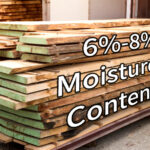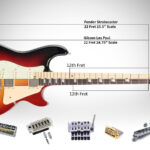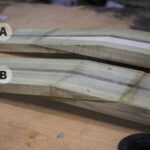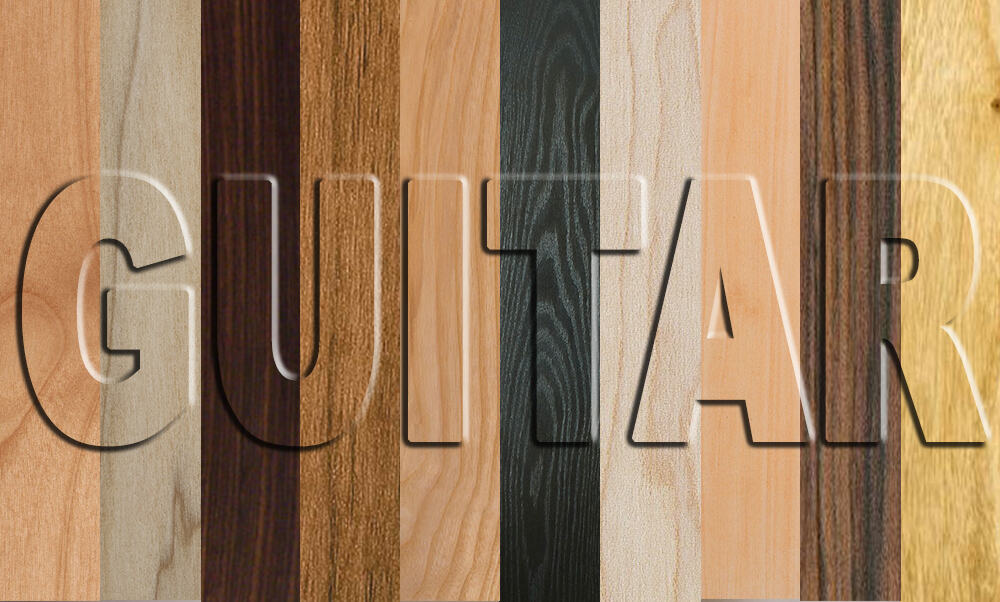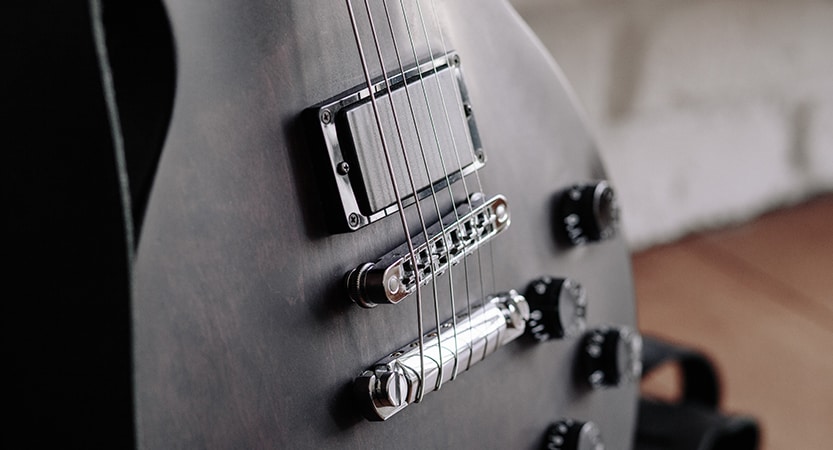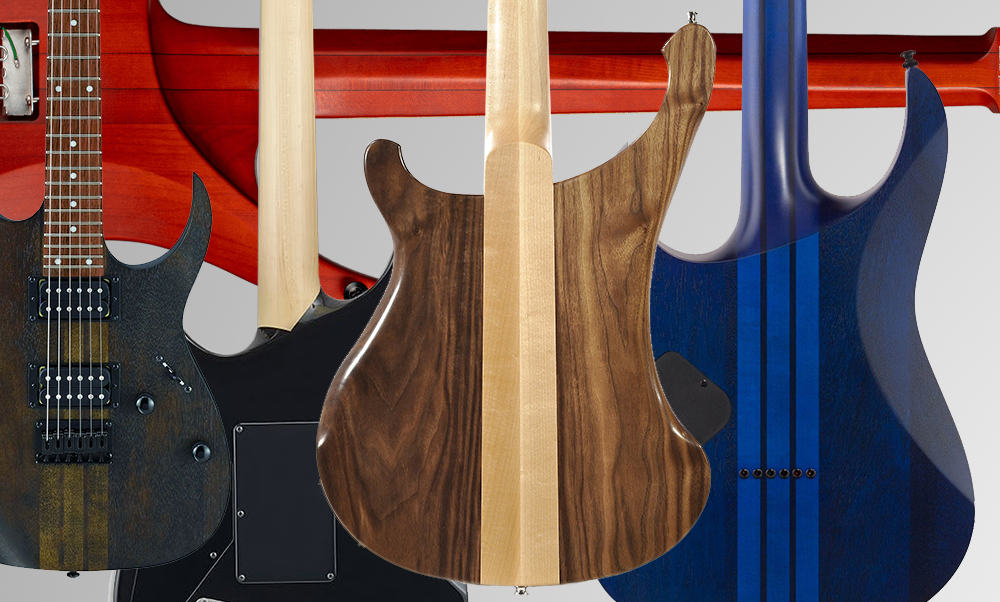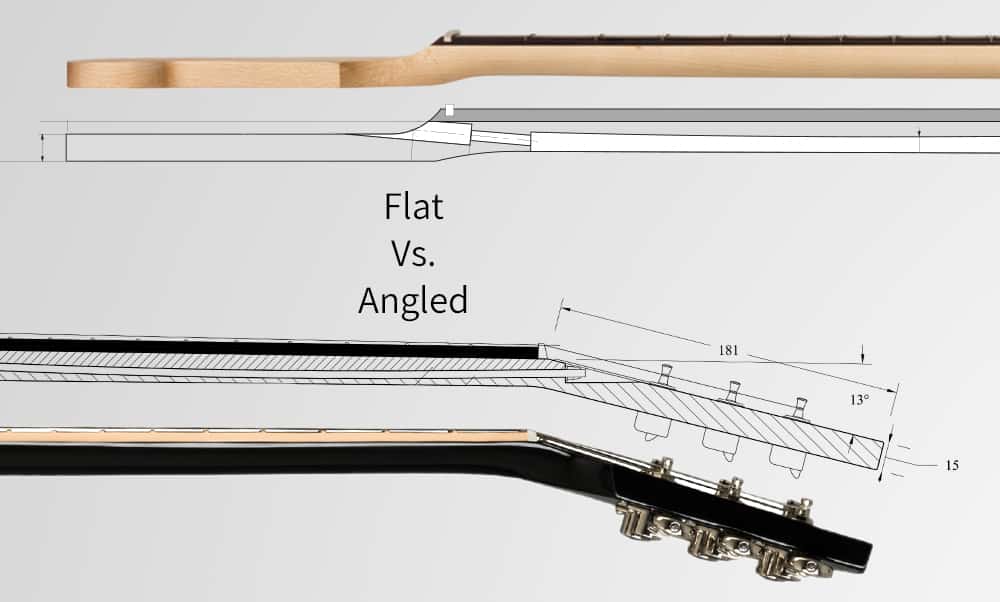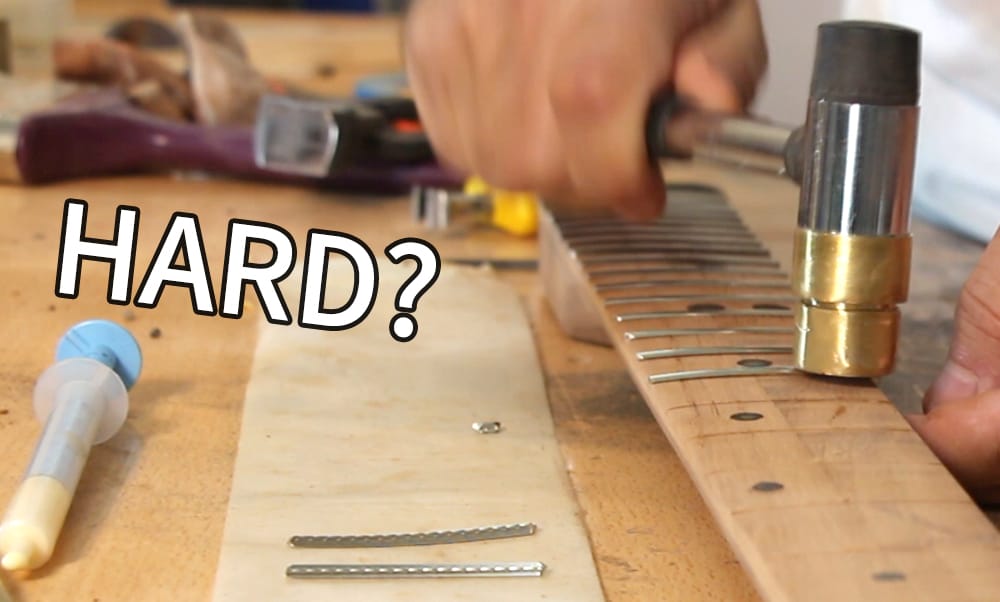Tonal Properties of Different Types of Guitar Wood
Having known the different popular guitar wood types, we will be taking a broader look at their features, looks, and tonal properties in this section. The guitar is made up of different parts. The body and neck fall among the most important parts of the guitar that dictates its tonal sound. These parts are often designed with single- or multi-wood.
Have it in mind that woods from different trees, regions or countries will sound slightly different, even though they may be of the same species. They will also be characterized by different weight and density. So when it comes to detecting tone difference, type of woods should be looked into, as well as other subtle factors.
For this section, we will be looking at the properties of different guitar woods under two subsections – The body and the neck.
The Body Woods
Alder

When it comes to guitar body construction, this is certainly one of the most popular types of woods used. It is almost impossible to talk about this type of wood without referencing Fender, which first made use of alder between the 1950s and 1960s. The alder is normally medium-weighted, although the cuts used for construction guitar bodies are expertly cut to weigh far less than most other types of wood. When it comes to sound production, alder will generally produce clear, strong and full-bodied sounds, combining beefy mids with excellent lows. When in its high, it may often give a slight sizzle that’s not necessarily harsh, but for sure, it offers a decent sustain. When in its dried state, alder takes a color that can easily pass as stylishly brownish. Alder’s grain doesn’t have a very interesting look, yet they don’t necessarily pass as unattractive, either. In guitar body construction, the alder is used typically under opaque finishes, although some examples still look great under darker translucent finishes. This type of wood often works well as body wood on its own.
Ash

Like alder, Ash is another popular wood type used for the construction of the guitar body. It shares many features and properties with the alder wood. Ash is popularly referred to as the wood for the classic 1950s Fender guitars, and it is best used in the form of swamp ash. Good swamp ash boasts of being generally light and resonant, and it carries a grain with a look that’s great under the translucent finish. The sound produced by the swamp-ash is airy, twangy, and sweet, often offering firm lows, slightly scooped midrange, and pleasant highs, with a generally good sustain. This type of wood is mostly denser and by extension heavier. It has a bright sound that can sometimes be confused as hard, more useful when looking for cutting, distorted sounds. Traditionally, ash is used more for constructing single-wood guitars, although you’ll sometimes find it in use for the design of multi-wood bodies.
Basswood

The most popular feature of basswood is its affordability and abundance. This type of wood is more particularly associated with the construction of mid-level guitars. Don’t take this to mean less quality, as the wood also shows amazing performance when used as a tonewood, and over the years, high-end makers have found ways to inculcate the wood for excellent results. What may amaze you is the extremely light and soft nature of this wood. It also has a relatively light color, with minimal grain. Solid basswood bodies are characterized by fat tonality that’s still well balanced. There’s this feeling of muscular midrange, although perfectly blend with a certain level of softness that’s commendable. When the guitar is constructed properly, the use of basswood can mean better dynamics, with the right grind level to bring the oomph factor to the sound.
Korina

The Korina is most popularly known for its role in the design and finish of Gibson’s radical modernistic series, which gained wave in the late 1950s. It was also a popular feature in models like the flashy flying V and Explorer – as well as recent guitars that have been designed in these templates. Korina is known to be naturally warm, resonant, and as a balanced performer. It also features great clarity, definition, and an impressive level of sustain. The species is called limba in some region, imported from Africa under the trade name Korina. As a special type of hardwood that’s fairly light in look, it brings a special style to the guitar construction, having a fine grain that designers usually enhance during the finishing process to look great. Black limba comes with a pronounced grain, while white limba takes a lighter appearance before enhancement.
Mahogany

Mahogany has been in use for years as a classic ingredient for the construction of both single-wood and multi-wood bodies. It is also a common wood for the construction of guitar necks. Since guitar became a thing in classical music, lots of designers have used solid mahogany for solid and semi-solid designs. The mahogany wood is mostly harvested in Africa and Central America. The wood is fairly dense and its weight locks somewhere between medium and heavy, depending on their sources. When used alone, the mahogany produces a warm and somewhat soft sound with the right balance of bite and grind. The sound is usually classified with having an impressive depth.
Maple

The maple is used for body and neck and of course, is a popular guitar wood. It is generally dense and heavy, harvested in the United States and Canada. Maple is mostly part of multi-wood bodies, where a lighter wood is used to give it the desired pattern. Single wood bodies made with maple also exist, although they are usually heavy – and when used alone, the maple body gives a tone that’s bright but precise, with tight lows. The wood is light-colored and as expected; its tightly packaged grain doesn’t come with figuring that is too dramatic, although some examples are quite spectacular on their own. Maple has always been a very important ingredient for semi-hollow electric guitars, helping to contribute to tightness and clarity.
Maple/Mahogany

If you are used to guitars and their builds, then you most probably would have seen this body type before. It is easily the most popular laminated body type that the guitar world has seen. When a solid maple top gets added to mahogany back, it brings forth a guitar body that’s characterized with the best tonal properties from both kinds of wood. This guitar body type features a look that’s rich, warm, and resonant. The combination brings a good deal of the mahogany’s smooth and appealing lows, combining it with an impressive sustain, as well as the added clarity, bite and definition that comes from the dense maple cap.
Poplar

Although classified as a hardwood, the poplar is still relatively soft in comparison to most other hardwoods. It is beginning to gain more popularity as the main ingredient for constructing the body of most Asian-made electrics, and it displays a quality that is best defined as bland and characterless. Although sonically balanced, constructions with poplar bodies are not particularly resonant, neither are they sustaining, and to be honest, they don’t look like they enhance any overtones or frequency range.
Rosewood

This tonewood is generally highly priced, and they are often seen in fretboards. They are also featured in the backs and sides of a wide range of flat-top acoustics with good quality. They are however hardly seen in solid body electrics. Guitars made of rosenwood are mostly heavy, with really bright sound – they are expensive too. Guitars made of this body type are for users that prefer good look and novelty to tone.
Lorem ipsum dolor sit amet, consectetur adipiscing elit. Ut elit tellus, luctus nec ullamcorper mattis, pulvinar dapibus leo.

Walnut
The Walnut wood type is generally dense and a bit too heavy to be called mid-weight. Its sonic characteristics are quite similar to what’s obtainable in mahogany. They are sometimes used for constructing the body of electric guitars. When constructed well, it looks warm and full, although with stronger low end, and better tightness. Walnut is generally richly brown in color, and when combined with pleasing grain patterns under simple coats, they give a very good look.
Exotics
Woods like wenge, koa, Purple Heart and bubing a are used for constructing custom guitars, but they hardly feat in mass guitar productions. These woods are most dense and hard, with grain patterns that can be easily identified. Their colors are appealing, even in their natural states and they are an important ingredient when multi-wood body guitars are constructed.
Neck Woods
For the woods used in constructing the guitar neck, lots of the woods that had featured in the body wood section will be repeated; however, we will be looking at their properties and build when used for the construction of the guitar neck. Although most guitar necks come with double wood construction, there are still a few that are constructed with single wood. The goal of the neck construction most of the time is to give the guitar a better look and of course to help its sound. The most popular woods used for guitar-neck construction are explained below
Mahogany/Ebony

Pairing mahogany with ebony wood in the guitar neck is something that has become popular in the upmarket. The ebony fretboard does its bit to bring better clarity, more tightness, as well as the better definition, as compared to when the mahogany is combined with rosewood in neck construction. The ebony is normally dense and hard. With a good construction, it offers a bass that’s quite muscular and controlled, with highs that are snappy and sizzling too. Getting the mahogany as the main ingredient for the back further brings warmth and some real openness to the brew, making it a pairing that any fan of good look will love. Guess what? It also doesn’t divot from long term finger and string pressure as easily and quickly as the rosewood.
Mahogany/Rosewood

The next most popular wood combination used for the design of the guitar neck is mahogany and maple combination. When the mahogany is paired with the rosewood, it results in a more porous, open wood without the maple’s hardness, stability, and strength. This type of neck wood is not suitable for use as fretboard material. The mahogany is naturally known to have a tone that is both warm and mellow, keeping a good presence in the lower mids. When paired with the rosewood, the mahogany contributes a complex degree of thick, highs and creamy lows.
Maple

Over the years, maple has gained ground as the most common wood type used for the construction of guitar necks. It has gained massive usage in almost all forms of necks, making it one of the most preferred choices by solid-body guitar designers. When used as a standalone wood for neck construction, the maple wood brings a special level of tightness and cut to the guitar build, combining an edge of moderate sizzle in the highs with some firm lows. It is not as much as a high-end wood as people will think when they hear of it, but it still a good choice for neck wood. Mids are characterized with snappy attacks when hit hard, but there’s still a good level of clarity when used at light or medium picks.
Maple/Pau Ferro

The tone of the pauferro is best described as being in the middle between rosewood and ebony. It brings a top of the end clarity, although it still features highs that are more complex than what’s featured in maple.
Maple/Rosewood

Bring a rosewood fretboard into the mix, and get the tonal of the maple neck blaring warmer and sweeter, featuring even more sparkle in the highs. The mid is characterized with a bit more openness. We can simply just refer to the contribution of rosewood to a neck made of maple as smooth.
The Great Tone-wood Debate
If you’ve followed the history of guitars, then you’d probably had heard about the ‘tone-wood’ debate – a great debate that has been raging hurt in the guitar world since the invention of the electric guitar in the 1920s. This is one debate that has torn friendship, families, and hearts apart, and for real, it continues till this day. You’re probably asking why a debate that originated from the innocent depths of the guitar world is causing such high level of chaos.
The debate is about how useful the electric guitar’s wood is. You didn’t think that was it, did you? Well, it is… Not politics this time, not sports… It’s a war being fought over the electric guitar’s Tonewood. This debate as small as you may think it leaves a wake of havoc anytime it comes up among guitarists and guitar lovers.
The best answer to this aged debate is actually simple… Simpler than a lot of people actually know.
Wait! Let’s give you some background information
The argument is about wood. Well, more specifically about the guitar Tonewood and if it affects the guitars sound.
Tonewood is a specially crafted dense wood used for its ability to cause a reverberation on an instrument. Its use has been experimented in a variety of instrument and it is generally believed to amplify sounds produced by an instrument.
The tonewood has survived use across centuries for creating various instruments, of course with different levels of success. Some Tonewoods perform better than the others. Let’s not go too far our discussion.
So, is The Tonewood Important?
Hell yes! Checkout the difference between the tonal qualities in acoustic guitars made with fine Tonewoods and that made of cheap plywoods and you’ll see that their difference is readily evident.
The better quality woods easily maintain the note sustain for a longer time than the cheaper woods do. They are also richer and sometimes produce deeper overtones.
Well, the same happens for almost all acoustic instruments made with wood. Some music experts have even argued in the past that instruments constructed with Tonewoods, gotten from the same tree can still vary in their tonal characteristics, despite having the same origin. So yes! It is important.
So how about electric guitars?
Well, this is where the argument gets tougher, isn’t it? It would seem like it should naturally play out the same way, right? When it’s about electric guitars, most times, things don’t play out like they really seem.
The argument about Tonewoods in electric guitars has lasted for really long. Maybe that’s why you often can’t talk about the guitar’s history, without mentioning this very confusing argument.
Well if we didn’t know the history of electric guitars, we’d have thought the argument was baseless. We can’t discuss the history in details, but one thing is sure. Makers thought the electric guitar will gain more acceptability if it was made to look like the more traditional acoustic. Of course, they rightly thought so and it was an effective strategy. But early players instantly assumed the electric guitar will work exactly the same way as the acoustic guitar since they had exactly the same look.
They are right, well… up until they got wrong. It has the same look and is played the same way, but the way the sound gets produced is entirely different.
Acoustics are designed to use string vibrations and their echoes to produce coordinated sounds, while electric guitars use magnets and magnetic fields. Electric guitars use “pick up” to translate vibration of the metal strings of a guitar into signals, which the amplifier turns into sound.
There lies the simple solution: strings lie directly above the pickups. The string directly vibrates on the pickup, which in turn translates signals to the amp for sound. So, the wood doesn’t have anything to do with it.
Or doesn’t it?
Let’s not forget that the vibration of the string is also affected by how and what materials hold the two tips of the strings. Since the two tips are also connected via the body and the neck. Although by pure physics the magnetic force created by the string’s vibration may be purely electric and mathematical, the quality and behavior of these vibrations is surely affected by the other materials that vibrate and resonate with the strings. As with many controversies, I have seen ‘blind tests’ which have been shown to prove either argument and therefore I would like to change the question from ‘Does the Type of Wood Affect the sound of an Electric Guitar?’ to ‘How Much Does the Type of Wood Affect the sound of an Electric Guitar?’.
Since it can’t really be measured, one may say that between the affect ‘Scale Length’ the ‘Pickups’ the ‘Hardware’ and the ‘Wood Itself’ have on the final sound, it is hard to determine how significant and noticeable the wood is. May be only those with very acute hearing can tell the difference, maybe it has only a minor affect which gets lost among all the other variables and maybe it makes no difference at all and we are just bias…
Environmental Impact of Using Woods for Guitar Construction
You might think it a little weird or overdramatic to bring the ecosystem into a discussion about guitars, but the truth remains that it matters a lot. At least, statistics have it that 2,630,950 guitars were sold in 2014 alone in the US. The global figure should be far more than that number.
Wood is an important instrument for constructing all those guitars and you don’t expect the woods to come from anywhere else apart from the trees. So the guitar industry is a significant player in this whole issue.
It’s not only about the figures. Apart from the production of several million guitars, over 200 species of woods are also used for guitar construction. Some of them are rare. These rare ones are of course harder to find, requiring clearing of larger areas of trees before they are accessed. So you see? The impact is really telling.
So what are the Alternatives?
Manufacturers already fear the dangers that continuous cutting of trees may soon pose to our ecosystem and as a result, they are already looking into alternatives. Some of the most popular eco-friendly alternatives that have been developed include:
- Bamboo: Bamboo presently holds the record as the world’s fastest growing tree and guess what? They can be used for guitar construction too. In fact, processed bamboo can actually bring better punch and tone than other woods.
- Flexwood: This solution is about using hybrid fibers, which can still retain tone quality.
- Recycle: The use of recycling in environmental protection cannot be overemphasized. It has been proven that recycled materials can actually make good guitars.
The Legend of ‘The Tree’
You know we will not end such an interesting topic without talking a little about ‘the tree’. Yes, the famous tree gotten from deep inside the rainforest jungle chiquibul in Honduras. You’re probably asking what the big deal about the tree is. What if I told you that guitars made from this famous tree sells for up to $40,000. Now you know how important it is to talk about this. So what makes the tree as extraordinary as it is?
The uniqueness of the tree is completely as a result of its history which dates to as far back as 1965 when it was first discovered. Have in mind that the tree had lived over 500 years before this time. Well, the tree stood at a height of over 100 feet and a base diameter of over 10 feet. Well to cut the long story short, the tree has fallen in the 1960s by a team of loggers who took up the task as a quest. According to legend, they achieved this with their axes. Well, the tree after being fallen didn’t leave the forest until the late 1970s. The popularity of the wood lies mainly in how beautiful it is. Lots of users have opined that it is the most beautiful tree anybody would ever see. It is worth seeing and owning.
Additional Related Questions
Do guitars sound better with age?
Well, some guitars don’t even live long enough to test because they sounded bad from the start. A bad sounding guitar will never improve with age. However, acoustic guitar according to many players, sound better as they age. The best way to explain this is that the wood begins to age, it gets lighter, therefore becoming more responsive.
Is Agathis a good guitar wood?
We can’t exactly say agathis is a bad wood, the same way we can’t exactly say mahogany is always excellent. Of course, you can use it as a tone wood, but to a large extent, its tonal qualities are affected by the way they are dried. If done well, it brings something good to the guitar, but if not, it doesn’t go well.
There you have it, the most popular types of guitar-woods and how far they have come. Before understanding the guitar, you’ll need to know about its builds and the woods that were used. The guitar is such an interesting instrument, but an understanding of its components makes it an even more amazing instrument to own.


